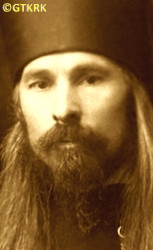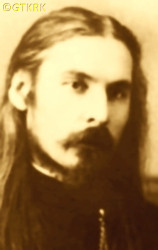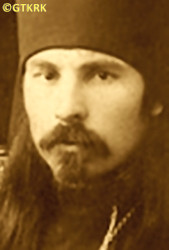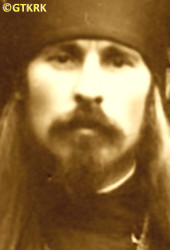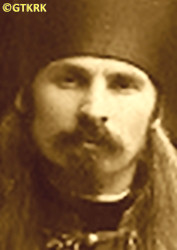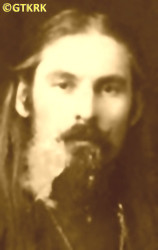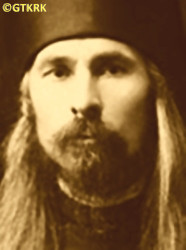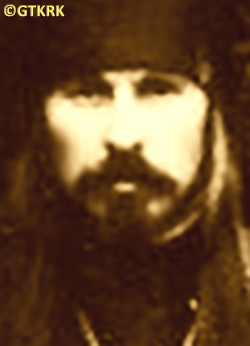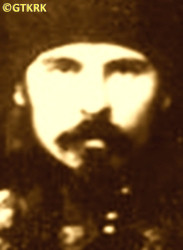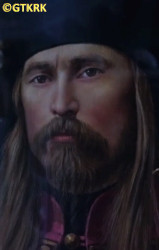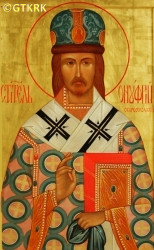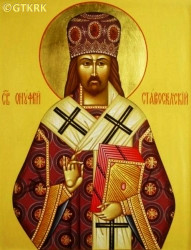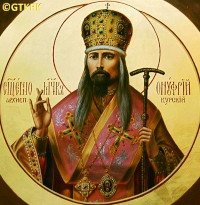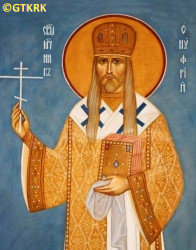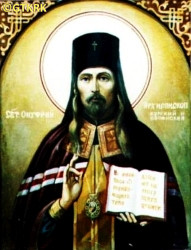Roman Catholic
St Sigismund parish
05-507 Słomczyn
85 Wiślana Str.
Konstancin deanery
Warsaw archdiocese, Poland
full list:
displayClick to display full list

searchClick to search full list by categories
wyświetlKliknij by wyświetlić pełną listę po polsku

szukajKliknij by przeszukać listę wg kategorii po polsku

Martyrology of the clergy — Poland
XX century (1914 – 1989)
personal data
religious status
saint
surname
GAGALUK
forename(s)
Anthony (pl. Antoni)
religious forename(s)
Onuphrius (pl. Onufry)

canonisation date
22.06.1993

Council of Bishops of the Ukrainian Orthodox Church
function
archbishop
creed
Eastern Orthodox Church ORmore on
en.wikipedia.org
[access: 2014.09.21]
diocese / province
Kursk‐Oboyan OR eparchymore on
ru.wikipedia.org
[access: 2020.09.24]
Staryi Oskol OR eparchy
Kherson and Odessa OR eparchymore on
ru.wikipedia.org
[access: 2020.09.24]
academic distinctions
Sacred Orthodox Theology Candidate
date and place
of death
01.06.1938

Blagoveshchensktoday: Amur oblast, Russia
more on
en.wikipedia.org
[access: 2022.06.29]
details of death
In 1918‐1919, during Russian civil war — a result of Bolshevik coup in Russian in 11.1917 — abducted by bandits, during a raid on St Gregory's monastery in Krasnyi Mayak where resided. The monastery was destroyed. Released by local peasants moved to nearby Beryslav.
On 10.02.1923, 6 days after his bishop's ordination arrested by Russian Bolsheviks in Yelisavetgrad and accused of opposing the so‐called the renovationist movement in Russian Church („Renovationist”, i.e. heretical, Orthodox Church, collaborating with Bolsheviks), not registering in NKVD offices after arrival and espionage. Held in Yelisavetgrad and Odessa. Released on 15.05.1923, after signing the pledge not to return to Odessa.
On 16.10.1923 arrested again by the Russians in Kryvyi Rih, after writing a pastoral letter criticising activities of so‐called Live Church (part of „Renovationist” Church). Held in Kharkiv prison. Released on 16.01.1924, with a ban on leaving Kharkiv.
On 09.12.1925 arrested again. Held in Kharkiv prison. In 1926 transferred to Butyrki prison in Moskow. On 05.11.1926 sentenced by a criminal Russian OGPU court to 3 years of exile in the village of Kudymkar in the Ural mountains.
In 10.1928, while in exile, arrested again and jailed in Tobolsk. On 11.02.1929 deported to the village of Surgut on the Ob River, and then in 09.1929 to the remote village of Uvat.
After the end of exile in 11.1929, without the right to settle in big cities, settled in Stary Oskol (during return, attacked several times, thrown from the train, arrested). Allowed to celebrate liturgy in one church only. Forbidden to visit other churches in the region. Thrice evicted from the apartment where lived.
In 03.1933 arrested yet again and accused of counter–revolutionary activities. After two weeks in Staryi Oskol prison transferred to Voronezh. Released in 06.1933.
In Kursk, where subsequently moved, was allowed to minister in one church only as well.
There on 23.07.1935 arrested yet again. Accused of making homilies too often, illegaly ordaining priests and supporting priests returning from exile — i.e. leading a counter–revolutionary group. On 09.12.1935 sentenced to 10 years of slave labour in Russian concentration camps Gulag.
Till 03.1936 held in the prison in the city of Orzeł. From there transported to the Russian slave labor concentration camp ITL DalLag.
Slaved in the NKVD kolkhoz/farm in Serednyobil village in Amur region.
There on 27.02.1938 — as a prisoner — accused of anti–Russian activities. Taken to Blagoveshchensk prison.
On 17.03.1938 sentenced by Russian genocidal kangaroo court, known as «NKVD Troika», to death.
Murdered in an unknown spot, in the group of a dozen or so clerics.
cause of death
mass murder
perpetrators
Russians
sites and events
11.08.1937 Russian genocideClick to display the description, Great Purge 1937Click to display the description, ITL DalLagClick to display the description, GulagClick to display the description, Moscow (Butyrki)Click to display the description, Forced exileClick to display the description, Kharkiv (prison)Click to display the description
date and place
of birth
02.04.1889

Opole Lubelskietoday: Opole Lubelskie gm., Opole Lubelskie pov., Lublin voiv., Poland
more on
en.wikipedia.org
[access: 2020.09.24]
parents
GAGALUK Maxim
🞲 ?, ? — 🕆 ?, ?

Catherine
🞲 ?, ? — 🕆 ?, ?
religious vows
05.10.1913 (permanent)
presbyter (holy orders)
ordination
08.12.1913

positions held
30.01.1934
archbishop — Russian Orthodox Church — dignity conferment
22.11.1933 – 15.12.1935
bishop — Kursktoday: Kursk reg., Kursk oblast, Russia
more on
en.wikipedia.org
[access: 2020.12.11] ⋄ Russian Orthodox Church ⋄ Kursk‐Oboyan OR eparchy — alternative date of starting this ministry in the eparchy: 05.12.1933
11.08.1933 – 22.11.1933
bishop — Belgorodtoday: Belgorod city reg., Belgorod oblast, Russia
more on
en.wikipedia.org
[access: 2023.07.16] ⋄ Russian Orthodox Church ⋄ Kursk‐Oboyan OR eparchy — Lat. locum tenens (Eng. „holding reins”), acting („ad interim”)
30.11.1929 – 27.06.1933
bishop — Russian Orthodox Church ⋄ Stary Oskol OR eparchy — with permission, issued by the Bolsheviks, to serve in only one church in the eparchial capital of Stary Oskol
1924 – 09.12.1925
bishop — Russian Orthodox Church ⋄ Odessa‐Kherson OR eparchy — Lat. locum tenens (Eng. „holding reins”), acting („ad interim”), ministering remotely, till the next arrest
04.02.1923 – 25.10.1926
auxiliary bishop — Yelisavetgradtoday: Kropyvnytskyi, Kropyvnytskyi city rai., Kirovohrad obl., Ukraine
more on
en.wikipedia.org
[access: 2021.09.17] ⋄ vicariate, Russian Orthodox Church ⋄ Odessa‐Kherson OR eparchy — arrested by the Bolsheviks 6 days after taking office; basically never returned to the city of his ministry, except for a short stay from 15.05.1923 to 16.10.1923, constantly arrested and sent/deported
04.02.1923
Bishop — Kievtoday: Kiev city rai., Kiev city obl., Ukraine
more on
en.wikipedia.org
[access: 2023.03.02] ⋄ Russian Orthodox Church ⋄ Dormition of the Mother of God OR monastery (Pechersk Lavra) — bishop's cheirotonia, i.e. ordination
1922 – 1923
rector — Kryvyi Rihtoday: Kryvyi Rih urban hrom., Kryvyi Rih rai., Dnipropetrovsk obl., Ukraine
more on
en.wikipedia.org
[access: 2022.02.15] ⋄ St Nicholas the Wonderworker OR church
1922
Archimandrite, i.e. superior abbot — Russian Orthodox Church — dignity conferment
c. 1918 – c. 1922
rector — Beryslavtoday: Beryslav urban hrom., Beryslav rai., Kherson obl., Ukraine
more on
en.wikipedia.org
[access: 2023.07.16] ⋄ Dormition of the Blessed Virgin Mary OR church
1915 – 1918
professor — Chervonyi Mayakalso: Krasnyi Mayak
today: Chervonyi Mayak hrom., Beryslav rai., Kherson obl., Ukraine
more on
ru.wikipedia.org
[access: 2023.07.16] ⋄ Pastoral and Missionary Seminary ⋄ OR monastery (Bizyukov monastery) — lecturer in Orthodox Church history
08.12.1913
hieromonk — Russian Orthodox Church — priesthood cheirotonia, i.e. ordination, preceded on 11.10.1913 by deacon cheirotonia and on 05.10.1913 by monk’s vowsa
c. 1912 – 1915
student — Sankt Petersburgtoday: Saint Petersburg city, Russia
more on
en.wikipedia.org
[access: 2020.07.31] ⋄ philosophy and theology, Orthodox Theological Academy — postgraduate specialised studies crowned with Sacred Orthodox Theology Candidate's degree
c. 1912
lecturer — Jabłecznatoday: Sławatycze gm., Biała Podlaska pov., Lublin voiv., Poland
more on
en.wikipedia.org
[access: 2021.12.18] ⋄ St Onuphrius OR monastery (stavropegial) — Orthodox theology for future teachers
till c. 1912
student — Chełmtoday: Chełm city pov., Lublin voiv., Poland
more on
en.wikipedia.org
[access: 2021.08.20] ⋄ philosophy and theology, Orthodox Theological Seminary
others related
in death
KULHAWIECClick to display biography Simeon, STEPANIUKClick to display biography George, GUDKOClick to display biography Basil (Bp Ambrose), NIKATOWClick to display biography Alex, OSTROUMOWClick to display biography Michael (Bp Seraphim), SAWICKIClick to display biography Yaroslav, SIENKIEWICZClick to display biography Alex, STROCIUKClick to display biography Leontius, BLUMOWICZClick to display biography John, SZACHMUĆClick to display biography Roman (Fr Seraphim), PANASIEWICZClick to display biography Emilian, MIEDWIEDIUKClick to display biography Vladimir, SMOLENIECClick to display biography Alexander (Abp Arsenius), MARCENKOClick to display biography Alexander (Abp Anthony), BORZAKOWSKIClick to display biography Alexander (Abp Agapit), DIERNOWClick to display biography Anatol (Abp Abramius)
sites and events
descriptions
11.08.1937 Russian genocide: On 11.08.1937 Russian leader Stalin decided and NKVD head, Nicholas Jeżow, signed a «Polish operation» executive order no 00485. 139,835 Poles living in Russia were thus sentenced summarily to death. According to the records of the „Memorial” International Association for Historical, Educational, Charitable and Defense of Human Rights (Rus. Международное историко‐просветительское, правозащитное и благотворительное общество „Мемориал”), specialising with historical research and promoting knowledge about the victims of Russian repressions — 111,091 were murdered. 28,744 were sentenced to deportation to concentration camps in Gulag. Altogether however more than 100,000 Poles were deported, mainly to Kazakhstan, Siberia, Kharkov and Dniepropetrovsk. According to some historians, the number of victims should be multiplied by at least two, because not only the named persons were murdered, but entire Polish families (the mere suspicion of Polish nationality was sufficient). Taking into account the fact that the given number does not include the genocide in eastern Russia (Siberia), the number of victims may be as high as 500,000 Poles. (more on: en.wikipedia.orgClick to attempt to display webpage
[access: 2016.03.14])
Great Purge 1937: „Great Terror” (also «Great Purge», also called „Yezhovshchyna” after the name of the then head of the NKVD) — a Russian state action of political terror, planned and directed against millions of innocent victims — national minorities, wealthier peasants (kulaks), people considered opponents political, army officers, the greatest intensity of which took place from 09.1936 to 08.1938. It reached its peak starting in the summer of 1937, when Art. 58‐14 of the Penal Code about „counter‐revolutionary sabotage” was passed , which became the basis for the „legalization” of murders, and on 02.07.1937 when the highest authorities of Russia, under the leadership of Joseph Stalin, issued a decree on the initiation of action against the kulaks. Next a number of executive orders of the NKVD followed, including No. 00439 of 25.07.1937, starting the liquidation of 25,000‐42,000 Germans living in Russia (mainly the so‐called Volga Germans); No. 00447 of 30.07.1937, beginning the liquidation of „anti‐Russian elements”, and No. 00485[2] of 11.08.1937, ordering the murder of 139,835 people of Polish nationality (the latter was the largest operation of this type — encompassed 12.5% of all those murdered during the «Great Purge», while Poles constituted 0.4% of the population). In the summer of 1937 Polish Catholic priests held in Solovetsky Islands, Anzer Island and ITL BelbaltLag were locked in prison cells (some in Sankt Petersburg). Next in a few kangaroo, murderous Russian trials (on 09.10.1937, 25.11.1937, among others) run by so‐called «NKVD Troika» all were sentenced to death. They were subsequently executed by a single shot to the back of the head. The murders took place either in Sankt Petersburg prison or directly in places of mass murder, e.g. Sandarmokh or Levashov Wilderness, where their bodies were dumped into the ditches. Other priests were arrested in the places they still ministered in and next murdered in local NKVD headquarters (e.g. in Minsk in Belarus), after equally genocidal trials run by aforementioned «NKVD Troika» kangaroo courts.
ITL DalLag: Russian Rus. Исправи́тельно‐Трудово́й Ла́герь (Eng. Corrective Labor Camp) ITL Rus. Дальне‐Восточный (Eng. Far Eastern) — concentration and slave forced labor camp (within the Gulag complex) — headquartered in Khabarovsk, capital in the Khabarovsk Krai. Founded in 1929 and subordinated to the genocidal Russian organizations of the GPU and NKVD. Prisoners slaved at the forest clearing and wood processing, mining of minerals — coal and gold, construction of industrial plants (e.g. cement production), construction of roads and railways (Birobidzhan‐Blucherovo/Leniskoye and Volochaevka‐Komsomolsk lines), regulating the course of rivers (e.g. Amur River), retention facilities on the Sedanka River near Vladivostok, work in workshops in Vladivostok and Khabarovsk, farming, fishing, etc. At its peak c. 112,000 prisoners were held there: e.g. 47,767 (01.01.1934); 59,515 (01.01.1935); 71,763 (01.01.1936); 112,490 (01.01.1937); 100,875 (01.01.1938); 64,600 (01.10.1938); 64,249 (01.01.1939). Ceased to exist on 13.04.1939. (more on: old.memo.ruClick to attempt to display webpage
[access: 2024.04.08])
Gulag: The acronym Gulag comes from the Rus. Главное управление исправительно‐трудовых лагерей и колоний (Eng. Main Board of Correctional Labor Camps). The network of Russian concentration camps for slave labor was formally established by the decision of the highest Russian authorities on 27.06.1929. Control was taken over by the OGPU, the predecessor of the genocidal NKVD (from 1934) and the MGB (from 1946). Individual gulags (camps) were often established in remote, sparsely populated areas, where industrial or transport facilities important for the Russian state were built. They were modeled on the first „great construction of communism”, the White Sea‐Baltic Canal (1931‐1932), and Naftali Frenkel, of Jewish origin, is considered the creator of the system of using forced slave labor within the Gulag. He went down in history as the author of the principle „We have to squeeze everything out of the prisoner in the first three months — then nothing is there for us”. He was to be the creator, according to Alexander Solzhenitsyn, of the so‐called „Boiler system”, i.e. the dependence of food rations on working out a certain percentage of the norm. The term ZEK — prisoner — i.e. Rus. заключенный‐каналоармец (Eng. canal soldier) — was coined in the ITL BelBaltLag managed by him, and was adopted to mean a prisoner in Russian slave labor camps. Up to 12 mln prisoners were held in Gulag camps at one time, i.e. c. 5% of Russia's population. In his book „The Gulag Archipelago”, Solzhenitsyn estimated that c. 60 mln people were killed in the Gulag until 1956. Formally dissolved on 20.01.1960. (more on: en.wikipedia.orgClick to attempt to display webpage
[access: 2024.04.08])
Moscow (Butyrki): Harsh transit and interrogation prison in Moscow — for political prisoners — where Russians held and murdered thousands of Poles. Founded prob. in XVII century. In XIX century many Polish insurgents (Polish uprisings of 1831 and 1863) were held there. During Communist regime a place of internment for political prisoners prior to a transfer to Russian slave labour complex Gulag. During the Great Purge c. 20,000 inmates were held there at any time (c. 170 in every cell). Thousands were murdered. (more on: en.wikipedia.orgClick to attempt to display webpage
[access: 2020.05.01])
Forced exile: One of the standard Russian forms of repression. The prisoners were usually taken to a small village in the middle of nowhere — somewhere in Siberia, in far north or far east — dropped out of the train carriage or a cart, left out without means of subsistence or place to live. (more on: en.wikipedia.orgClick to attempt to display webpage
[access: 2014.12.20])
Kharkiv (prison): Russian criminal prison where in the 1930s a number of Catholic priests were held prior to being sent to Russian concentration camps.
sources
personal:
pl.wikipedia.orgClick to attempt to display webpage
[access: 2020.09.24], drevo-info.ruClick to attempt to display webpage
[access: 2020.09.24], kuz1.pstbi.ccas.ruClick to attempt to display webpage
[access: 2020.09.24]
bibliographical:
„Hierachy, clergy and employees of the Orthodox Church in the 19th‐21st centuries within the borders of the Second Polish Republic and post–war Poland”, Fr Gregory Sosna, M. Antonine Troc-Sosna, Warsaw–Bielsk Podlaski 2017
original images:
drevo-info.ruClick to attempt to display webpage
[access: 2020.09.24], commons.wikimedia.orgClick to attempt to display webpage
[access: 2020.09.24], polit.ruClick to attempt to display webpage
[access: 2020.09.24], www.pravmir.ruClick to attempt to display webpage
[access: 2020.09.24], commons.wikimedia.orgClick to attempt to display webpage
[access: 2020.09.24], www.facebook.comClick to attempt to display webpage
[access: 2021.12.19], www.kursk-sestry.ruClick to attempt to display webpage
[access: 2020.09.24], www.facebook.comClick to attempt to display webpage
[access: 2020.09.24], www.facebook.comClick to attempt to display webpage
[access: 2021.12.19], kuz1.pstbi.ccas.ruClick to attempt to display webpage
[access: 2020.09.24], www.facebook.comClick to attempt to display webpage
[access: 2020.09.24], azbyka.ruClick to attempt to display webpage
[access: 2020.09.24], www.k-istine.ruClick to attempt to display webpage
[access: 2021.12.19], kursk-sestry.ruClick to attempt to display webpage
[access: 2020.09.24], stefanikka.narod.ruClick to attempt to display webpage
[access: 2020.09.24], www.facebook.comClick to attempt to display webpage
[access: 2021.12.19]
LETTER to CUSTODIAN/ADMINISTRATOR
If you have an Email client on your communicator/computer — such as Mozilla Thunderbird, Windows Mail or Microsoft Outlook, described at WikipediaPatrz:
en.wikipedia.org, among others — try the link below, please:
LETTER to CUSTODIAN/ADMINISTRATORClick and try to call your own Email client
If however you do not run such a client or the above link is not active please send an email to the Custodian/Administrator using your account — in your customary email/correspondence engine — at the following address:

giving the following as the subject:
MARTYROLOGY: GAGALUK Anthony
To return to the biography press below:
 Click to return to biography
Click to return to biography








